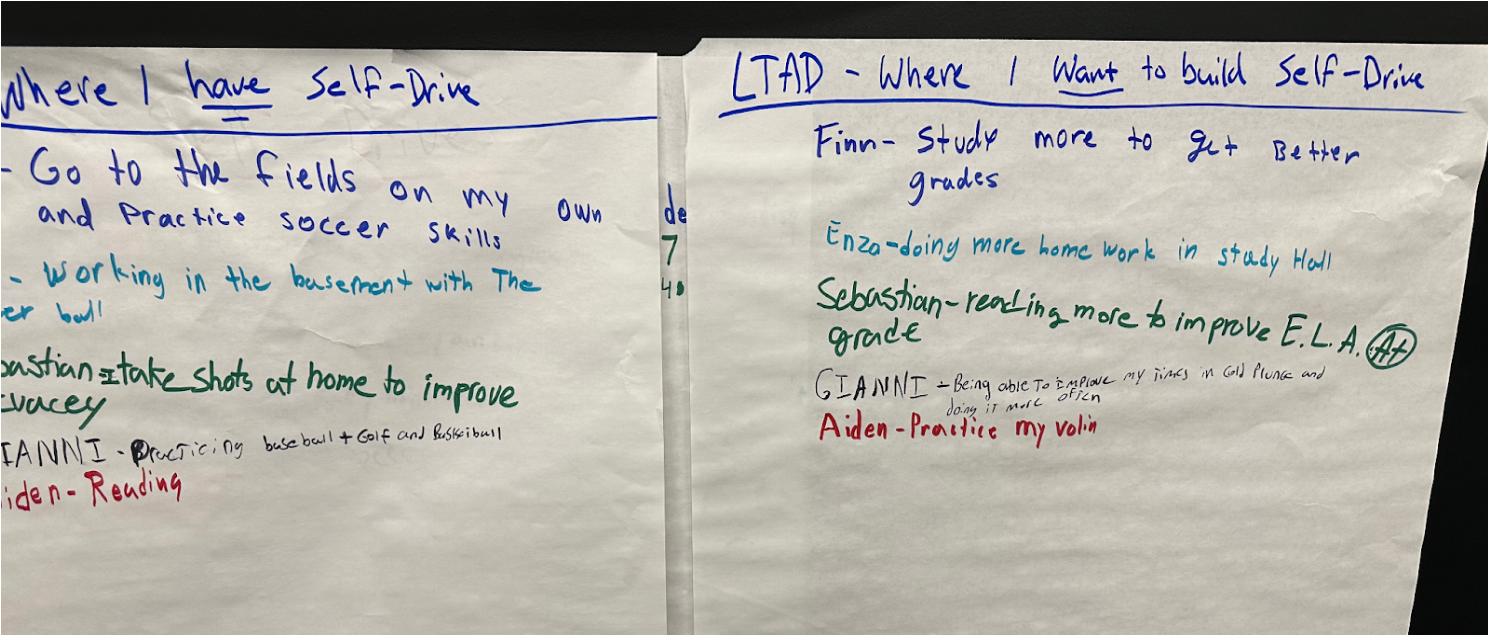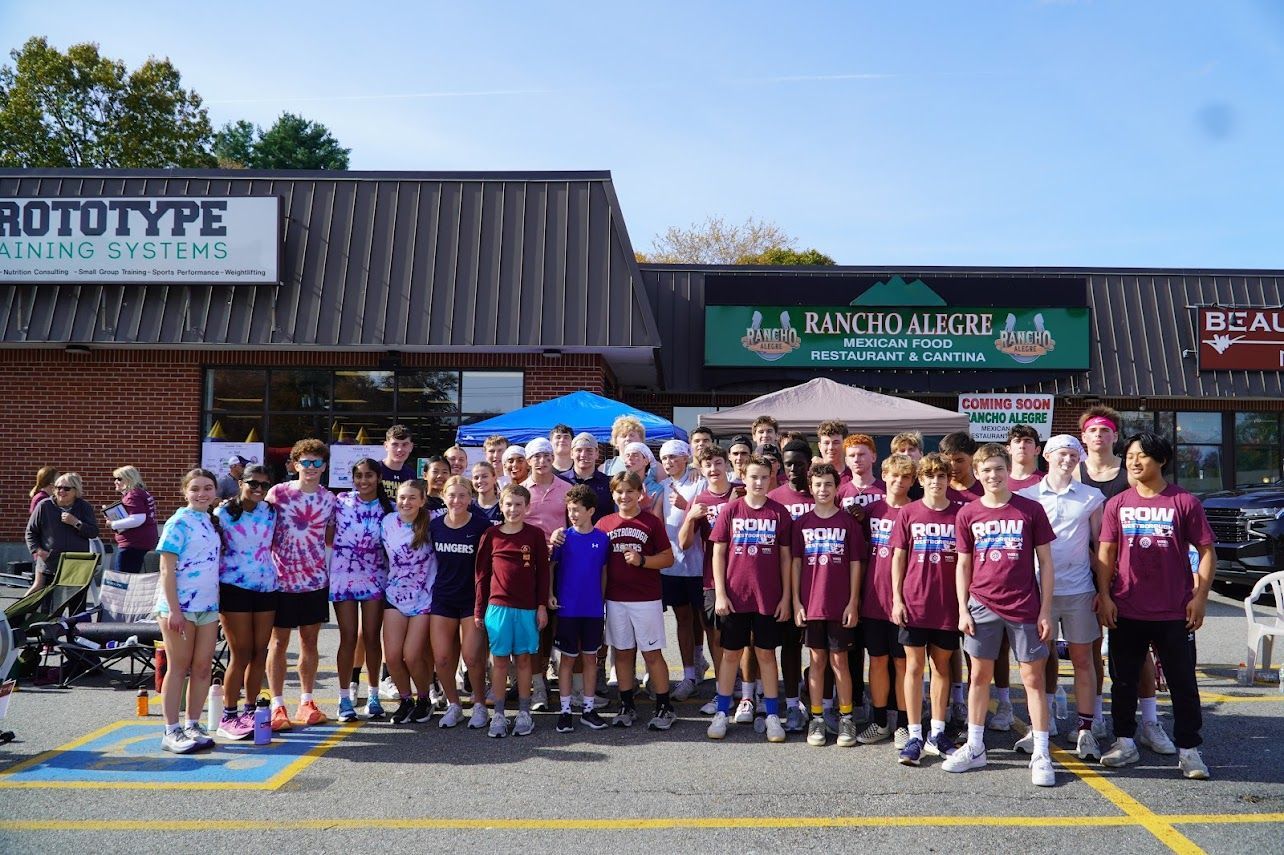Developing Young Leaders: Self-Drive: The Root to Accomplishing Anything
November 8, 2024
Self-Drive: The Root to Accomplishing Anything

Self-Drive is a Trainable Skill
The first time I heard that self-drive is a trainable skill, I had to pause for a second. I had never really thought about it that way. I always assumed I had self-drive for the things I enjoyed or was naturally good at—it didn't seem like a skill, it just felt natural.
But the more I thought about the areas in my life where I exhibit self-drive, the more I started to see the habits and rituals I built around improving at those things. Once I understood that, the next step was figuring out how to apply those same principles to areas in my life where I wanted to develop self-drive.
This is what we’re working on with the LTAD group this week. The first step for them was to identify where they already have self-drive. Here are some of the areas the kids shared:
Where I have Self-Drive
- "Going to the field to practice soccer on my own."
- "Working in the basement with the soccer ball."
- "Taking shots at home to improve my accuracy."
- "Practicing baseball, golf, and basketball."
- "Reading."
These answers didn't come out immediately. Before we started the workout, I asked them to think about things they felt driven to do. At first, they listed tasks they felt they had to do, like homework or cleaning their room.
This highlighted an important aspect of self-drive: it has to come from within. Self-drive isn’t about doing something just to please your parents or avoid getting in trouble—it’s about something you’re motivated to do for yourself. This doesn't mean they shouldn’t do tasks like homework, but understanding the root of their self-drive is key to replicating it across different areas of their lives.
After we discussed this and went through the workout, the kids were able to identify the areas where they truly felt self-driven, and those are the examples they shared above.
Before we started breaking down their habits and rituals around their self-driven skills, I asked them another question: "What is something you would like to have self-drive in?"
Where I want to build Self-Drive
- “Study more to get better grades”
- “Doing more homework in study hall”
- “Reading more to improve E.L.A (A+)”
- “Being able to improve my time in the cold plunge and do it more often”
- “Pratice my volin”
My belief is that by helping them see the gap between the areas where they have self-drive and where they don’t, it will become easier for them to identify the habits that drive them and apply those same habits to other skills they want to improve.

Next week, we'll work on identifying the fears and frustrations that can prevent them from developing these skills.
Previous Blogs

Devon is a fantastic part of our community — always kind, coachable, easy-going, and consistently putting in the work. She shows up, supports others, and truly represents what PTS is all about. Prototype of the Month is well deserved! Below, she answers a few questions about her time at PTS. 1.) Share your experience at Prototype After what felt like an entire year of sitting during grad school, I knew I wanted to be more active. I came back to Prototype, and it was the best decision. I’ve made so many new friends here who make every class fun (no matter how tough the workout is) but my favorite moment has to be meeting my boyfriend Ed! 2.) What is your favorite part about being at Prototype? I used to do at-home workouts and always felt like something was missing. When I came to Prototype, it felt like I finally found that missing piece, the community! It truly makes a huge impact. Everyone here genuinely wants the best for you. 3.) What are your hobbies and activities? If I’m outside, I love playing pickleball, skiing, and going for walks. And if I'm inside I enjoy crocheting, reading, or baking! 4.) How has Prototype helped you or solved a problem for you? Prototype has shown me that if you put your mind to something, you can truly do hard things. I also know I will always feel better after going to the gym. Sometimes the hardest part is just getting in the car, but I never regret it once I’m there. 5.) What are you continuing fitness goals to this point? To get some form of movement everyday and to one day get a pull up. 6.) Favorite Quote “Laughter is timeless, imagination has no age, dreams are forever.” -Walt Disney

Tim has been an incredible part of our community — always positive, funny, generous, and willing to help. His energy makes everyone around him better. Prototype of the Month is well deserved! Below he answers some questions about his time at PTS. 1.) Share your experience at Prototype This actually isn’t my first stint at Prototype - I’ve been around and worked out here a few times in my heyday. My very first legitimate class though, as a member, was 5am earlier this year and I was welcomed first by Nicole. You can all imagine how that interaction went… and I came back! Prototype is welcoming, fun, clean, and I’ve made amazing friends along the way. It is one of the best hours of my day. 2.) What is your favorite part about being at Prototype? Prototype is not just another workout but a mental reset for me, it fills my cup. 3.) What are your hobbies and activities? Activities mostly involve time with my family outside whenever we can, trips to Ptown and traveling all over for work. I have a hard time sitting still and typically keep a busy schedule. Mix in photography and interior design opportunities with fitness and family and I’d say that's my perfect mix. 4.) How has Prototype helped you or solved a problem for you? I work remotely so in person face to face conversation is something I’ve found I need for my mental health. I’m also super competitive so I tend to push a little harder when I workout with others. 5.) What are you continuing fitness goals to this point? I want to be a parent who can show up for their kids in every aspect of life, which also means physically. Staying fit is important to be able to keep up with them as we collectively get older. I am training for a few Hyrox races coming up but mostly just trying to maintain my current level of fitness for as long as possible. 6.) Favorite Quote “There is only one success - to be able to live your life in your own way” -Fortune Cookie
Climb to New Heights
Prototype Training Systems is more than a gym - it is a lifestyle. Join us today!


